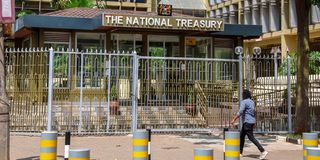Audit of State bank accounts start ahead of centralisation

The National Treasury building in Nairobi.
What you need to know:
- The directive targets government ministries, agencies and departments.
- It also targets State corporations, county governments and their entities.
The National Treasury has started an audit of the bank accounts held by national and county government entities to pave the way for rollout of a Treasury Single Account (TSA) which was approved by the Cabinet in January.
The directive targets government ministries, agencies and departments, State corporations and semi-autonomous government agencies, public funds and projects, county governments and their entities.
In a letter dated March 26 and sent to all the affected agencies, Treasury Principal Secretary Chris Kiptoo directed the entities to provide particulars of the accounts including the name of the bank, branch, account number and the identities of the signatories to the same.
Other details include the currency designation of the account, the balance as at February 29, 2024 and whether the account is active or dormant.
According to the Treasury, public entities held over 33,000 bank accounts in the local sector as at January 2023.
“As part of the implementation process, the National Treasury is updating the record of all the bank accounts held by public entities, at national and county government levels, pursuant to Section 28 (6) of the PFM Act 2012,” said the PS in the letter.
“The purpose of this communication therefore is to request you to submit information on all bank accounts held by yourselves, as at close of business on February 29, 2024…Please provide the information by April 15, 2024.”
A TSA is either one or a set of interlinked accounts that a government handles for the financial transactions of its MDAs.
Kenya has opted for a hybrid model that allows entities to maintain their separate accounts which are linked to a central account.
All funds in these accounts must, however, be transferred to the primary TSA account at the end of each day.
Identifying the number of accounts held by the different entities and the amount of money they hold is the first step towards effecting the TSA, which was first mooted a decade ago as one of the solutions to leakage of public resources.
Although the Treasury promised in budget statements since 2016 to put in place the TSA, the single account did not take off, reflecting the amount of legal and regulatory work required.
It would also require investment in a system to interlink the various government agencies, oversight bodies and the National Treasury to allow for real-time payments between accounts.
In January this year, the Cabinet finally gave its nod to implement the system, eyeing the billions in deposits held in commercial banks by the national government and other public sector entities.





